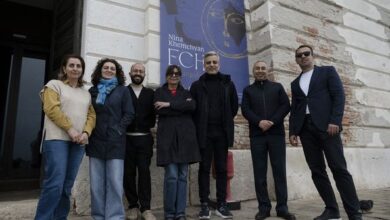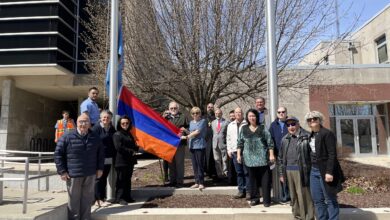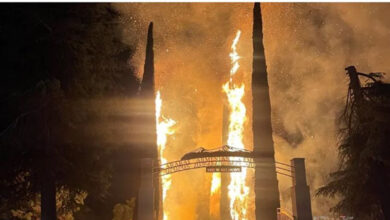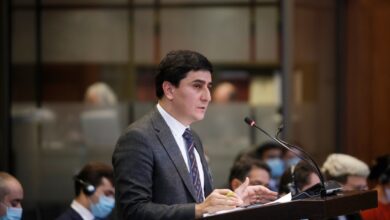Lecture on Armenian Genocide at Fresno State
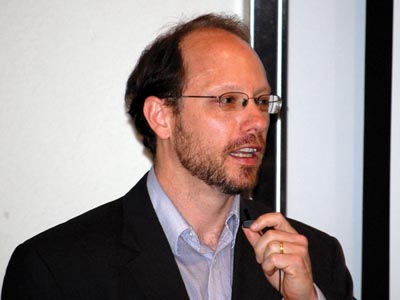
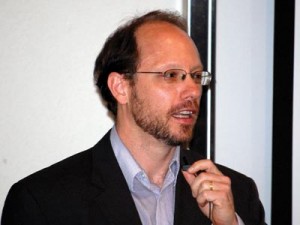 Dr. Sergio La Porta, professor in the armenian studies program, concluded this years’ Fresno State Talks last night in the , with a lecture on the importance and relevance of the Armenian Genocide and how it shaped world civilization today, reports The Collegian, a student-run newspaper that serves the Fresno State Community.
Dr. Sergio La Porta, professor in the armenian studies program, concluded this years’ Fresno State Talks last night in the , with a lecture on the importance and relevance of the Armenian Genocide and how it shaped world civilization today, reports The Collegian, a student-run newspaper that serves the Fresno State Community.
Entitled “Who Cares? Genocide, Historical Memory, and Moral Responsibility,” La Porta’s lecture emerged from his own personal history with Armenian studies as a graduate of Harvard University.
Lucy Garayan, a senior psychology student, joked that although La Porta’s last name did not end in a “ian” representative of the Armenian heritage, his expertise and love of the field and the people inspired his students through his lectures and knowledge to learn more about the culture.
“At the time, I thought Armenian role in history was minute,” Garayan said. “Armenia today is the size of Maryland, however, it was in Dr. La Porta’s class that I learned about a rich and powerful history. I felt it was my duty to learn about my own culture and history, but in fact it is the duty of all Armenians to study our history and language. It is through knowledge that we can keep our traditions alive.”
La Porta began his lecture with an introduction into the history of the Armenian Genocide, which began on April 24, 1915, when the Young Turk regime of the Ottoman Empire arrested 250 Armenian intellectuals who were soon murdered after their seizure.
In the next four months, La Porta said, the regime murdered 800,000 Armenian citizens of the empire, at a rate of 200,000 people a month, comparable to the Rwandan Genocide. By 1923, approximately 1.5 million people had been murdered by the Young Turk forces, and over 500,000 people displaced.
“Now, 100 years later, this crime against humanity, this genocide, remains unrecognized by the Republic of Turkey,” La Porta said. It’s historical reality is consistently questioned, not only insulting the memory of millions of people, but also denying them historical justice and their inherent human dignity.”
La Porta spoke about local events commemorating the Armenian Genocide, including the memorial currently being built on campus set to be revealed on April 23 and coordinated with the Republic of Armenia.
Other local events include the Armenian Genocide Centennial Committee, a philharmonic concert April 25, the current art exhibit at Fresno Art Museum, and a town hall meeting on March 16.
La Porta noted the similarity of the Armenian Genocide to that of the Holocaust during World War II. He explained that there was a specific organization employed for the mass extermination of Armenians, legalizing and putting into effect laws which authorized the deportation of Armenians and seizure of their property–millions of acres of land and possessions, which La Porta said led to part of the modern economic basis of Turkey today.
“We realize that this is not a random set of killings, but an organized attempt to eliminate a portion of the population,” La Porta said.
He spoke of the horrors of the genocide, in which modern technology such as telegraphs and railways were used. Armenians were transported in packed cars where they often suffocated to death.
“To add insult to injury they were often forced to buy their ticket first, then packed into these cars, and often the train would stop in the desert and have them taken out and murdered,” he said.
To this day, La Porta says, the Armenian Genocide fails to be recognized by the Republic of Turkey.
“The argument that they make was that many Turks died during World War I, as if this negates the atrocities that occurred,” La Porta said. “Yes, a lot of Turks did die in World War I, and a lot of Armenians died as well. The difference was a lot of Turks died fighting in World War I, a lot of Armenians died because they were executed.”
But La Porta said that from the destruction, there is still an opportunity to show a better side of human nature through the internationalization of the Armenian Genocide. Through American aid and relief, La Porta called this one of the greatest moments in american history.
“People often say that’s not that important, nobody remembers it, nobody knew about it. This is completely untrue. People knew about the Armenian Genocide very well. The New York Times had over 200 articles on the Armenian Genocide between 1915 and 1922.”
According to La Porta, between 1916 and 1930, The American Committee for Relief in the Near East (today known as the Near Eastern Relief Fund) raised 116 million dollars in relief aid for Armenians and others similarly affected, (equivalent to 1.5. billion dollars today.) La Porta said that this was the largest relief effort ever launched in the United States.
The effects of the Armenian Genocide, La Porta said, are still very alive and present today.
“It destroyed a vital sector of Armenia, also caused the Armenian diaspora, part of the economic basis for the economy of Turkey, and allowed the Republic of Turkey to form its modern capital. We see that this process of nationalism and of purity beginning with the Armenian Genocide. We can chart its progress in the early 20th century.”
He says that remembrance may be crucial in honoring those that were lost.
“Never again, Armenians will never again allow themselves to be executed in the way that happened in 1915. The Armenian Genocide continues to penetrate current political conflicts in the middle east.”
Amongst many stories of the survivors, La Porta says there is no debate about the reality of the Armenian genocide, and the reality of who was responsible.
“The genocide is a historical fact,” La Porta said. “It’s important to remember that they didn’t just disappear. They didn’t just die. They were killed by an agent, and that agent was the Ottoman Turkish regime of the Young Turks. This moral distancing is understandable because it’s uncomfortable to think that people could do this to one another. Yet we need to be honest about it. We need to say who did it. We need to be clear about who did it to overcome the trauma of the genocide itself.”
La Porta concluded his lecture by demonstrating the power of memory.
“Actually remembering is not stopping us from going forward,” he said. “It’s the catalyst that allows us to engage in acts of humanity.”



